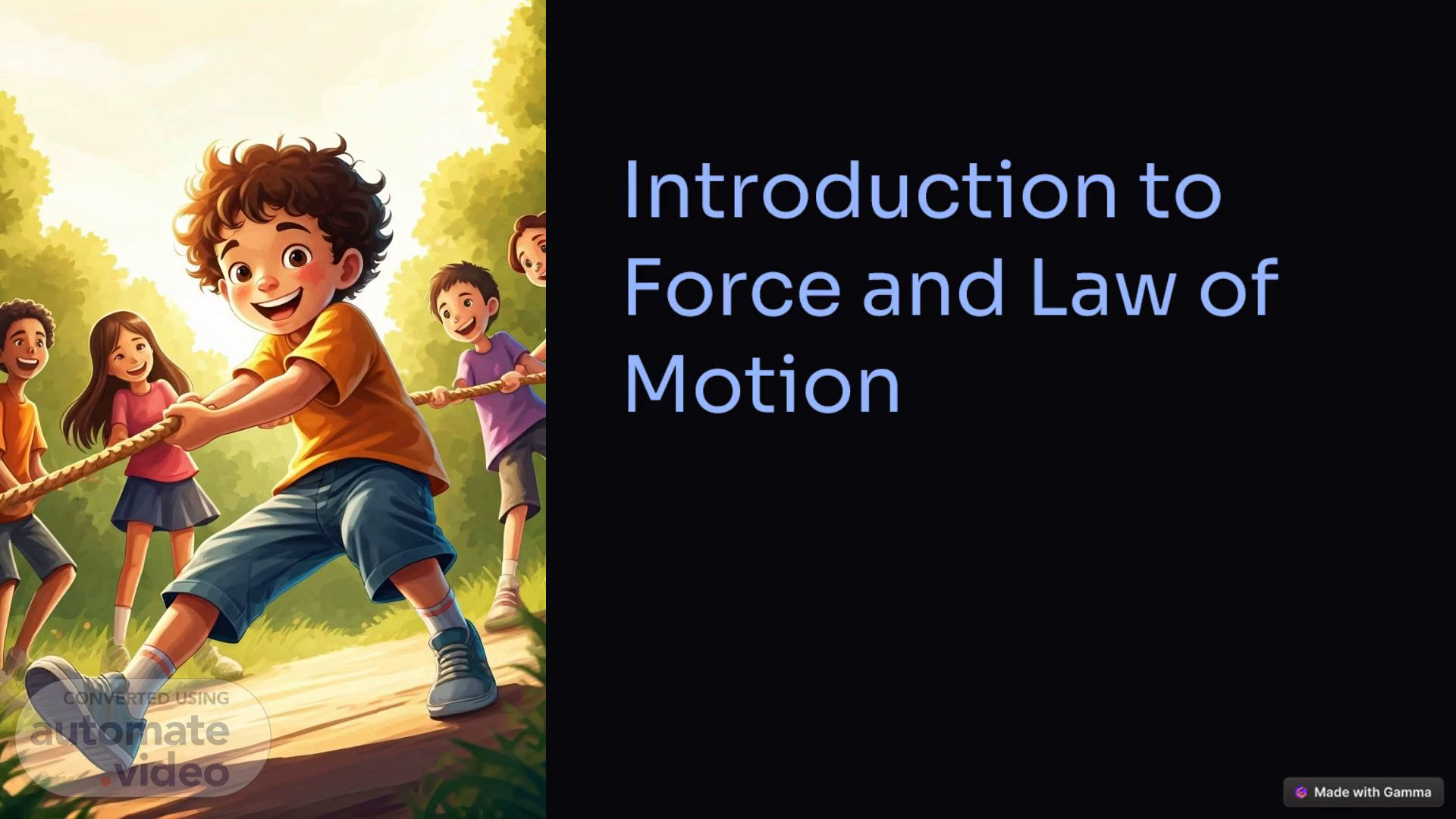Scene 1 (0s)
[Audio] We'll delve into the foundational laws of motion formulated by Sir Isaac Newton. In this presentation, we'll understand the concept of force. Force is a push or pull that can change the motion of an object. It can be applied to an object from an external source, such as gravity or friction, or it can be generated internally, such as in the case of an object that is undergoing a chemical reaction. We'll examine the three laws of motion established by Sir Isaac Newton. These laws provide a framework for understanding the relationship between force and motion, and they are still widely studied and applied in a variety of fields today. We'll explore each law in detail, and we'll see how they can be used to predict the motion of objects in a variety of situations..
Scene 2 (49s)
[Audio] Let's discuss the properties of force. In simple terms, force is a push or pull that can cause a change in an object's motion. It can make an object start moving, stop moving, or change its direction or speed. Every object in the universe is subject to various forces acting upon it. There are two main types of force: contact force and non-contact force. Contact force occurs when objects directly touch each other, such as pushing a door or pulling a rope. This type of force can be both push and pull, depending on the direction of the force. Non-contact force, on the other hand, acts on objects even when they are not in direct contact. Examples of non-contact force include gravitational force, magnetic force, and electromagnetic force. Understanding the properties of force is essential to understanding the motion of objects. We will explore these properties in more detail in the next slide..
Scene 3 (1m 51s)
[Audio] Examine the fundamental laws of motion, first introduced by Sir Isaac Newton, to analyze object movement. These laws govern the behavior of objects and provide a foundation for understanding the various types of forces that exist..
Scene 4 (2m 7s)
[Audio] Law of inertia is fundamental to understanding how objects behave and interact with their environment..
Scene 5 (2m 15s)
[Audio] Newton's Second Law of Motion explains how force, mass, and acceleration are related. When the net force on an object is changed, its acceleration also changes. This law applies regardless of the direction of the force acting on an object. In addition, a larger mass requires a greater amount of force to achieve the same acceleration as a smaller mass..
Scene 6 (2m 40s)
[Audio] We established the foundational laws of motion that govern the way objects move. Our Third Law of Motion states that for every action, there is an equal and opposite reaction. This means that when one object exerts a force on another object, the second object exerts an equal and opposite force on the first object. For example, when a rocket engines burn fuel and expel hot gases, the hot gases push back on the rocket, propelling it upwards. This is an example of an action and reaction, with the rocket exerting a force on the hot gases and the hot gases exerting an equal and opposite force on the rocket. Our Third Law of Motion is a fundamental principle that applies to all objects in motion, and it is essential to understanding the way objects move and interact with each other..
Scene 7 (3m 30s)
[Audio] We will discuss the core principles that govern the motion of objects. We will examine the foundational laws of motion developed by Sir Isaac Newton that have shaped our understanding of the world. We will explore the force of friction that opposes the motion of an object when it is in contact with a surface. Friction is caused by the microscopic irregularities between the surfaces in contact, which create resistance to movement. We will examine two types of surfaces today: rough and smooth. Rough surfaces have more friction than smooth surfaces because they have more irregularities that create resistance to movement. Weight is another factor that can affect the force of friction. The greater the weight of an object, the more friction it will have..
Scene 8 (4m 20s)
[Audio] Cars, trains, airplanes, and rockets all utilize the principles of force and motion to move objects through space. In sports such as baseball, cricket, and football, forces affect the motion of the ball. Machines rely on the laws of motion to function, converting energy into useful work through simple devices like gears and pulleys or complex systems like engines and turbines. The laws of motion have numerous applications in our daily lives and various fields of science and engineering..
Scene 9 (4m 56s)
[Audio] It is calculated by multiplying an object's mass and velocity. Momentum is a conserved quantity, meaning that the total momentum of a closed system remains constant. This principle is referred to as the law of conservation of momentum. Linear momentum is a specific case of momentum where the object is moving in a straight line. It is calculated by multiplying an object's mass and velocity in the direction of motion. Linear momentum is a vector quantity, meaning that it has both magnitude and direction. Comprehending the principles of momentum and its conservation is vital for predicting the motion of objects and gaining a thorough understanding of physics..
Scene 10 (5m 41s)
[Audio] We have completed our presentation on the fundamental principles of motion. We have studied the three laws of motion and their practical applications in daily life. These principles are vital in the creation of new technologies and the resolution of motion-related issues..
